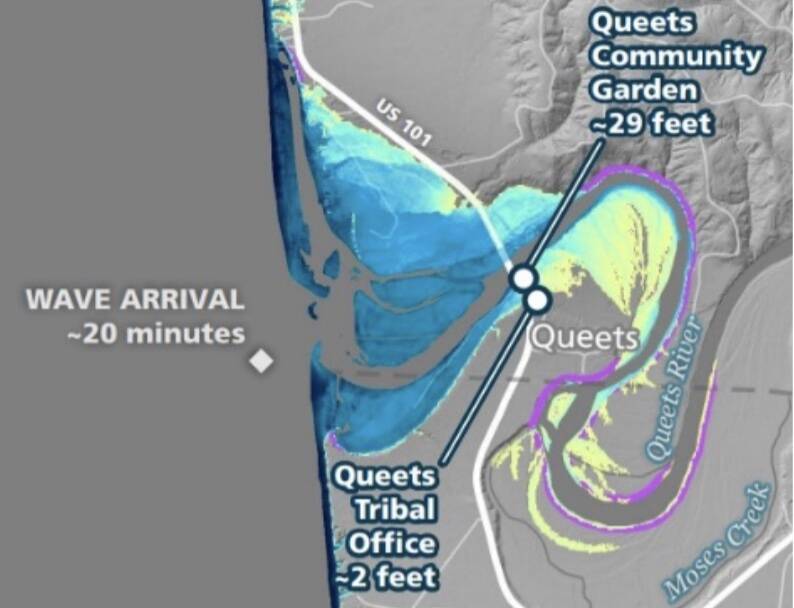When the Washington state House and Senate proposed their respective capital budgets last month, each included nearly $12 million devoted to the village relocation efforts of the Quinault Indian Nation on the Washington coast.
Those efforts are focused on two towns: Taholah, on the southern end of the reservation, home to about 700 people; and Queets, where a few hundred people live on the northern part of the reservation, near the border of Grays Harbor and Jefferson counties.
While each lies in a different stage of a long process of planning and development, both share the same goal — move buildings and neighborhoods to higher ground, away from rising sea levels, severe weather and flooding caused by climate change, and the looming threat of a tsunami.
Proposed capital budget funding, which is still under consideration of both houses of the legislature and needs the signature of Gov. Jay Inslee, would kickstart the Queets plan while sponsoring a key infrastructure upgrade in Taholah, said Ryan Hendricks, councilor on the Quinault Business Committee and one of the tribe’s leading construction managers.
Hendricks said the tribe recently finished buying out “Allotment 100,” a section of land designated for relocating the Queets village.
“Now that we officially own (Allotment 100), we are ready to start working on a master plan just like we have here in the Taholah village,” Hendricks said.
The Taholah Village Relocation Master Plan was adopted in 2017, and now the Legislature is proposing $1 million for that purpose in Queets. Hendricks said the tribe still needs to decide whether the work on the plan will be completed “in-house” or employ a contractor.
Geologic and engineering analysis, as well as environmental review in compliance with the National Environmental Policy Act, must be conducted before clearing the land for development — the first phase of the project.
Hendricks said the Taholah project is about halfway through Phase 1, but the Queets project is “a little bit behind” that stage.
According to the tribe’s request for funding, about 50 acres of land straddling Highway 101, south of the current Queets village, has been designated for development outside the tsunami inundation zone.
Experts predict a 10% to 17% chance of a magnitude 9.0 earthquake on the Cascadia Subduction Zone fault in the next 50 years, which would trigger a tsunami and inundate coastal areas with 60-100 feet of water, according to the Washington state Department of Natural Resources.
Queets is “particularly vulnerable to tsunamis and flooding” because of its isolation, the request states.
Moving the village would not only get people and buildings out of harm’s way, but could provide opportunity for more housing, according to the funding request. The Quinault Housing Authority has a waitlist of people wanting to move to Queets, where there is currently no available housing due to the lack of infrastructure on the reservation.
The tribe has plans for several projects on higher ground in Queets, including a water treatment plant, a veteran’s memorial park and a cemetery, but $8 million in proposed state funding would sponsor a first priority — a “Generations” building, which acts as a children’s learning center, daycare, senior center and disaster evacuation building.
A similar building was completed in 2021 in Taholah, although the Queets version would be one-third of the size at 10,000 square feet. Should it get the funding, Hendricks said, the project is “shovel ready” with blueprints already completed, although it could be a year to 18 months before planning comes together and work begins.
The last piece of state funding would provide for a key piece of infrastructure in Taholah, where village plans are further along.
There, the tribe has already cleared higher ground to build 59 houses in what’s called the “Northeast Neighborhood,” but the system that supplies the area with water — one Taholah has relied on for “decades” — is unreliable, Hendricks said.
Currently the Tribe draws water from an aquifer eight miles inland and pumps it across the Quinault River. The main water line is supported by a bridge that has “failed inspections time and time again” and an “unstable” platform, Hendricks said. In addition, the water source is nearing its “maximum capacity,” according to Hendricks.
But $2.6 million in proposed state funding would go toward a new water tank and pump house, and the tribe will tap into a new aquifer.
“It will essentially end up re-feeding the entire relocation itself,” Hendricks said. “We wouldn’t really be able to develop any of these three phases without this water pump and the pump house. It was a pretty crucial part for us.”
The remaining $150,000 of proposed funding will go toward a new cultural museum in the upper Taholah village to house “art, artifacts, records and to showcase cultural artifacts” in a safe space, according to the tribe’s funding request.
The proposed funding comes from Tribal Climate Adaptation Pass-Through Grants as part of the state’ Climate Commitment Act, which the Legislature passed in 2021.
Hendricks said these funds would be the first specific allotment for the Queets project from outside the tribe. Last year, the Quinault Indian Nation was one of three tribes to receive a $25 million federal relocation grant as part of President Joe Biden’s Bipartisan Infrastructure Law and Inflation Reduction Act. Hendricks said the tribe, along with federal agencies, is still working on the details of what that allocation will support.
Contact reporter Clayton Franke at 406-552-3917 or clayton.franke@thedailyworld.com.



